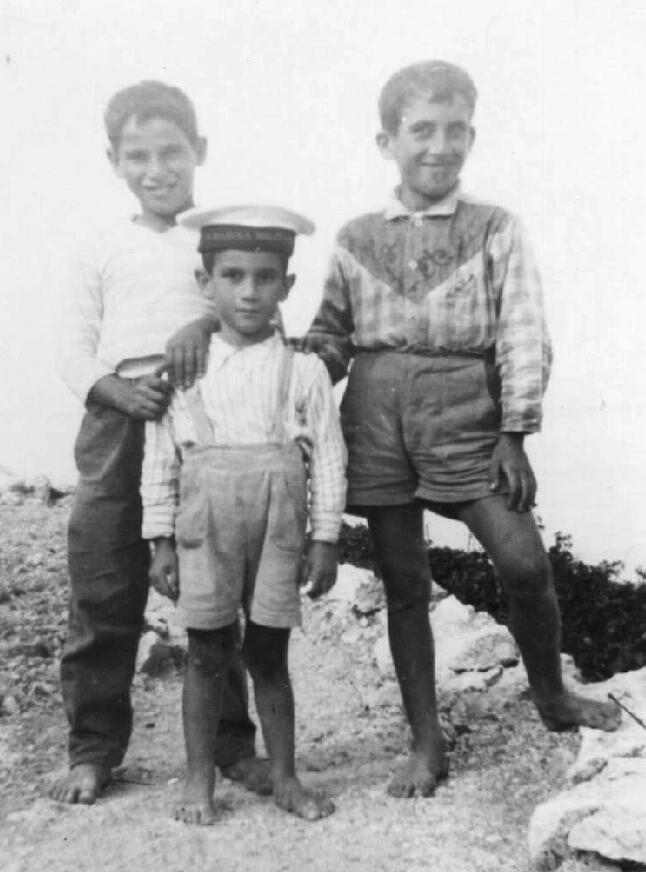
Italian Footwear: Chronology--The 20th Century

Figure 1.--Many Italian children went barefott during the first half of the 20th century. Both poverty and climate were factors. World War II which devestated Italy was another factor. This was especially common in coastal villages. This photograph was taken on Ponza island in late 1940s. The boys depicted in the photos were sons of fishermen.
|
|
The footwear worn by Italian boys have varied sigificantly over time. We have begun to collect more information on the 20th century based on the photographic record. We see Italian children wearing a variety of footwear, many of the same stylesas worn elsewhere in Europe. Sandals seem to have been more popular in Italy than in northern Europe, presumably because of the warm climate. Seasonality was of course a factor. Many Italian children continued to go barefoot because of the endemic poverty until after World War II. The warm climate made going barefoot posible. This did not begin to change until until the economic expansion in part because of the Common Market (forerunner of the European Europe) began to transform Italy economically. Up until the 1950s, social class was a major factor in footwear. As the income levels increased in the 1950s, many working-class Italians could afford the same footwear for their children as middle-class parents. Sneakers took longer to catch on in Italy than some countries, but were a major footwear style by the 1980s.
The 1900s
Many Italian children continued to go barefoot because of the endemic poverty until. This continued to be common until after World War II. Here both climate and poverty were factors.
The 1940s
Many Italian children continued to go barefoot because of the endemic poverty until after World War II (1940-45). The warm climate made going barefoot posible. Italy was poor before World war II, the country was devestated by the War as the Allies landed in the south (1943) and fought their way north through Rome to the Po River Valley (1945). We see large numbers of Italian boys going barefoot throughout the 1940s, but especially in the aftermath of the War. We note sandals being commonly worn in Italy, especially open-toe sadals, during the 1940s.
The 1950s
The situation where a large number of Italian children going barefootb did not begin to change until until the 1950s when the economic expansion in part because of the Common Market (forerunner of the European Europe) began to transform Italy economically. Up until the 1950s, social class was a major factor in footwear. As the income levels increased in the 1950s, many working-class Italians could afford the same footwear for their children as middle-class parents.
The 1960s
We begin to see Italian children wering footwear like sneakerts that were poplar throughout Europe. Climate continued to indluence footwear and we see sandals and flip-flops being worn more in Italy than the rest of Europe. A reader writes, "When I was in Italy during in 1961, the blue sandals you referred to were very popular for boys and girls. The style was also very popular in white."
The 1970s
Sneakers were not as common as now. Most of the children wore close-toe sandals. Those blue sandals were very common. They were worn both with and without socks. Clogs were another choice for the children. Otherwise that in Germany. Italian children usually wore clogs without socks. During 1970s bare feet became less common in Italy. However there were kids that went barefoot in their own backyard or also in the neighborhood.
The 1980s
Sneakers took longer to catch on in Italy than some countries, but were a major footwear style by the 1980s. A reader writes, "Assuming the sandals were cooler to wear in Italy's hot climate (summer), I don't understand why sneakers became so popular there." Well, comfort is certainly a factor in clothing, but it is not the only factor. Fashion is often more important than comfort. Sneakers were not only comfortavle they were fashionable among teenagers and as a result, younger boys also wore them. They were also more practical for sports in football (soccer) made Italy. During the first half of the 20th century you can often tell whwew a boy was from based on his clothing. By the 1980s this had generally ended and both boys and girls were wearing a kind of American-influenced pan-European fashion and both jeans and sneakers were a very important part of that look. Of course in Italy, sandals never disappeard. We see both boys and girls wearing them, but they were no longer the principal type of footwear.
HBC

Navigate the Boys' Historical Clothing Italian pages:
[Return to the Main Itlalian page]
[Italian art]
[Italian catalogs]
[Italian choirs]
[Italian movies]
[Italian royalty]
[Italian school uniforms]
[Italian youth groups]
Navigate the Boys' Historical Clothing Web Site:
[Return to the Main Italian footwear chronology page]
[Return to the Main Italian footwear page]
[Introduction]
[Activities]
[Biographies]
[Chronology]
[Cloth and textiles]
[Clothing styles]
[Countries]
[Topics]
[Bibliographies]
[Contributions]
[FAQs]
[Glossaries]
[Images]
[Links]
[Registration]
[Tools]
Created: 7:56 PM 6/19/2008
Last updated: 6:34 AM 7/7/2009



